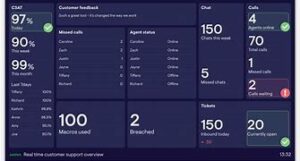In the contact centre world, managing resources effectively stands as a crucial but continual challenge. The key to a successful contact centre lies in its ability to balance supply and demand, ensuring optimal occupancy and reducing staff attrition. This article delves into how contact centres can improve resource management through an effective workforce optimisation (WFO) strategy.
 Understanding the Dynamics of Supply and Demand in Contact Centres: The first step towards effective workforce optimisation is understanding the fluctuating nature of supply (the people) and demand (customer contacts). Contact centres can often face unpredictable spikes in contact be that call volumes, webchats and emails and varying patterns in customer interactions can be volatile. Analysing historical data and predicting future trends are essential in aligning staff schedules with expected demand. Utilising speech analytics and text analytics can give valuable insights into the nature of demand.
Understanding the Dynamics of Supply and Demand in Contact Centres: The first step towards effective workforce optimisation is understanding the fluctuating nature of supply (the people) and demand (customer contacts). Contact centres can often face unpredictable spikes in contact be that call volumes, webchats and emails and varying patterns in customer interactions can be volatile. Analysing historical data and predicting future trends are essential in aligning staff schedules with expected demand. Utilising speech analytics and text analytics can give valuable insights into the nature of demand.
Implementing Flexible Scheduling: Flexibility in scheduling is a cornerstone of workforce optimisation. It enables contact centres to adjust staffing levels in real-time, based on actual demand. This approach not only ensures that customer inquiries are handled efficiently but also reduces unnecessary downtime for staff, leading to better job satisfaction and lower attrition rates. Having a reasonable mix of Full time and part time and term time staff can help increase the volume of resource available during some of your core hours so consider the mix in your team to create flexibility during core hours and also how you then choose to schedule people, perhaps the nature of your team might mean split shifts could work well or shorter shifts on some days and longer on others – be creative with how you schedule based on your demand.
Leveraging Technology for Enhanced Workforce Management: Advanced WFO software plays a pivotal role in resource management. These tools provide real-time analytics, forecast demand, automate schedule planning, and offer insights into staff performance. By harnessing the power of technology, contact centres can make data-driven decisions, streamline operations, and enhance overall efficiency. As mentioned before using Speech and text analytics tools can help you gather intelligence on the demand type and frequency but it also pavers the way for you to start to leverage AI in your responses to customer enquiries and creative more self serve pathways that can integrate Speech, text and CRM tools. Thinking about how your customers want to engage with you can help you think more holistically about how you manage the demand in the centre.
tools provide real-time analytics, forecast demand, automate schedule planning, and offer insights into staff performance. By harnessing the power of technology, contact centres can make data-driven decisions, streamline operations, and enhance overall efficiency. As mentioned before using Speech and text analytics tools can help you gather intelligence on the demand type and frequency but it also pavers the way for you to start to leverage AI in your responses to customer enquiries and creative more self serve pathways that can integrate Speech, text and CRM tools. Thinking about how your customers want to engage with you can help you think more holistically about how you manage the demand in the centre.
Fostering Skill Development and Versatility: Developing a multi-skilled workforce is vital in optimising resource utilisation. Cross-training agents to handle various types of customer interactions ensures a more flexible workforce that can be deployed effectively as per the changing demands. This not only improves service levels but also aids in employee growth and satisfaction, further reducing turnover rates. Having an omni channel skilled workforce can also help manage multiple types of contact at the same time, although be sure to recruit train and plan for this type of communication as it can be quite overwhelming layering voice on top of email onto of live chat and can leave cause for error, deciding if you are Omni channel, blended or multichannel is a good start point.
 Promoting Employee Engagement and Well-being: An often-overlooked aspect of workforce optimisation is employee well-being. Engaged and satisfied employees are more productive and less likely to leave. Implementing strategies that focus on staff well-being, recognising achievements, and offering career development opportunities are crucial in maintaining a motivated and stable workforce. Managing Customer demand effectively means happier customers which usually drives higher CSAT and fewer complaints which can mean much nicer conversations across the board which helps with employee satisfaction. Also consider shrinkage as part of your engagement plan, are you allowing enough time for development and well being in your shrinkage calculations, we can all say we are employee centric but if training is the first thing to be pulled when the service level hits the fan are we being truly employee centric?
Promoting Employee Engagement and Well-being: An often-overlooked aspect of workforce optimisation is employee well-being. Engaged and satisfied employees are more productive and less likely to leave. Implementing strategies that focus on staff well-being, recognising achievements, and offering career development opportunities are crucial in maintaining a motivated and stable workforce. Managing Customer demand effectively means happier customers which usually drives higher CSAT and fewer complaints which can mean much nicer conversations across the board which helps with employee satisfaction. Also consider shrinkage as part of your engagement plan, are you allowing enough time for development and well being in your shrinkage calculations, we can all say we are employee centric but if training is the first thing to be pulled when the service level hits the fan are we being truly employee centric?
Implementing Continuous Improvement Processes: Continuous improvement is better then delayed perfection! There is never a right time or right blend of resource that’s going to give you a magic wand and fix all the resourcing issues so continuous improvement is key to maintaining an optimised workforce. Regularly reviewing processes, and having a robust capacity planning review process will help optimise the schedules and allow great forecast accuracy. Gathering feedback from staff and customers, and making iterative changes can lead to substantial improvements in both efficiency and service quality.
Measuring Success and Making Adjustments: Finally, the effectiveness of a workforce optimisation strategy must be measured through key performance indicators (KPIs) such as average handle time, customer satisfaction scores, and employee turnover rates. AHT shouldn’t be used as a stick to whack agents across the knuckles with but used as a planning tool to define resource requirements, with that said we should be encouraging team leaders to coach around call control and look at those over and under AHT tolerance to see if we can share best practice or understand trends and what the changing call mix may be. Regularly monitoring these metrics allows for timely adjustments to the strategy, ensuring continuous alignment with the centre’s goals.
performance indicators (KPIs) such as average handle time, customer satisfaction scores, and employee turnover rates. AHT shouldn’t be used as a stick to whack agents across the knuckles with but used as a planning tool to define resource requirements, with that said we should be encouraging team leaders to coach around call control and look at those over and under AHT tolerance to see if we can share best practice or understand trends and what the changing call mix may be. Regularly monitoring these metrics allows for timely adjustments to the strategy, ensuring continuous alignment with the centre’s goals.
So in summary effective workforce planning in contact centres is not a one-time effort but an ongoing process. By understanding the dynamics of supply and demand, leveraging technology, fostering employee development, and continuously measuring and refining processes, contact centres can create a more efficient and robust operation. This not only enhances customer satisfaction but also builds a more content workforce, ultimately leading to sustained success in the challenge that can be delivering awesome customer service.
